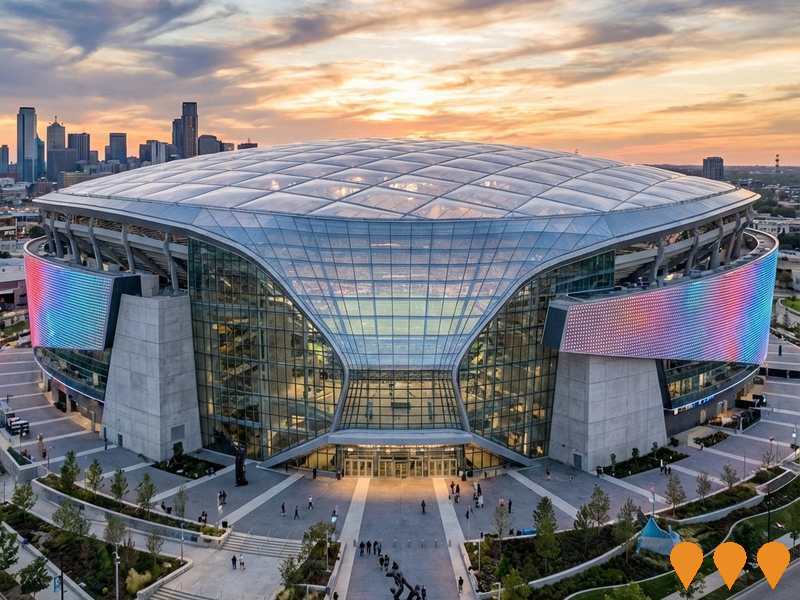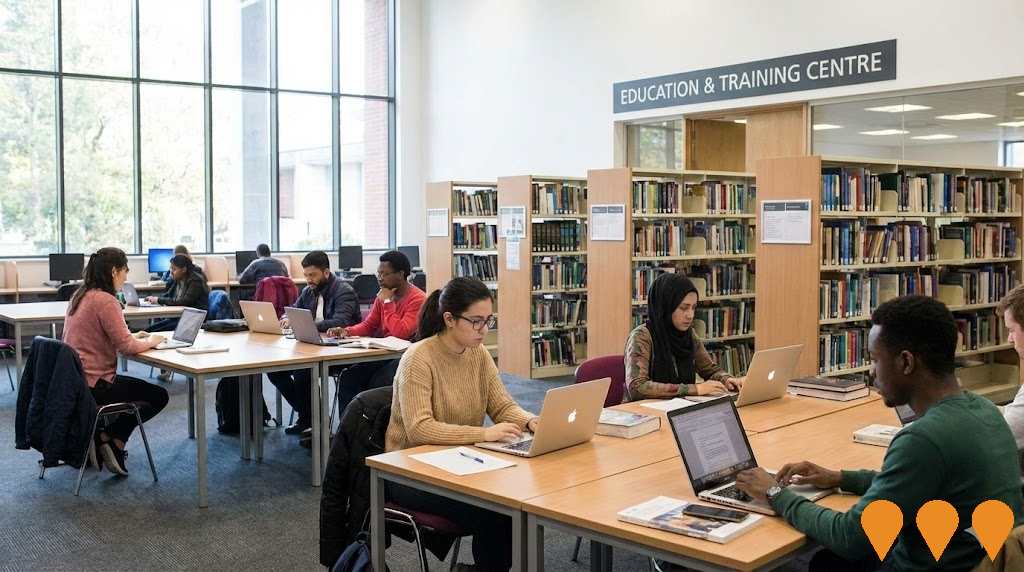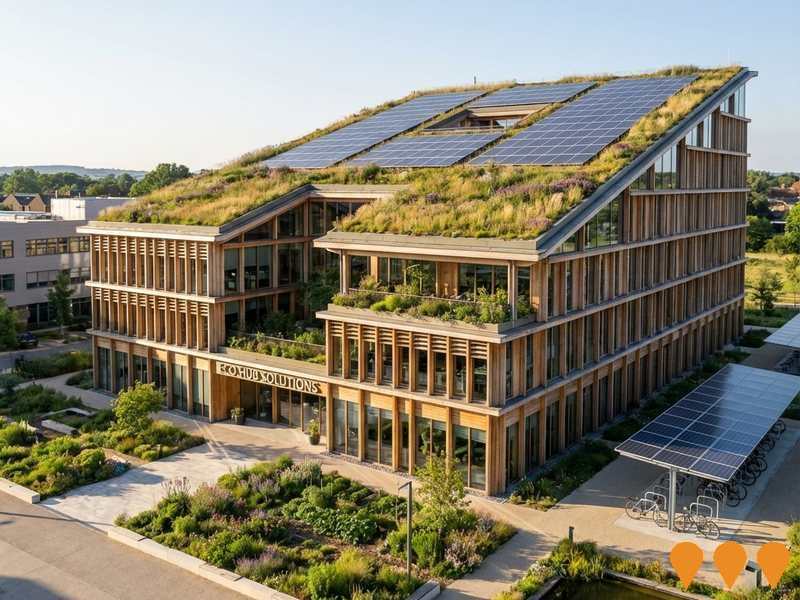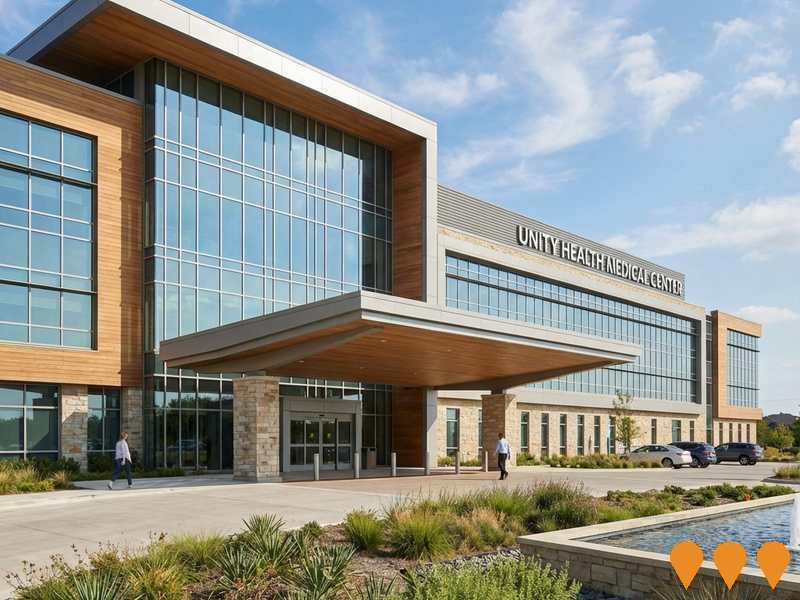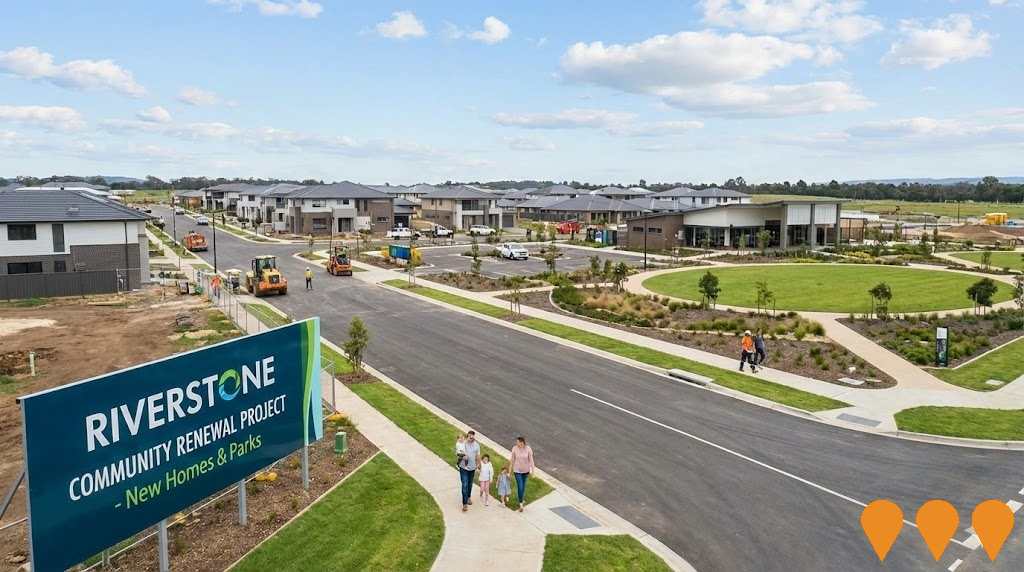Chart Color Schemes
est. as @ -- *
ABS ERP | -- people | --
2021 Census | -- people
Sales Activity
Curious about local property values? Filter the chart to assess the volume and appreciation (including resales) trends and regional comparisons, or scroll to the map below view this information at an individual property level.
Find a Recent Sale
Sales Detail
Population
An assessment of population growth drivers in Mayfield - Warabrook reveals an overall ranking slightly below national averages considering recent, and medium term trends
Mayfield-Warabrook's population, as per AreaSearch's analysis, is approximately 16,116 as of August 2025. This figure represents an increase of 590 individuals, a rise of 3.8% since the 2021 Census which recorded a population of 15,526. The change is inferred from the estimated resident population of 15,965 in June 2024 and an additional 294 validated new addresses since the Census date. This results in a population density ratio of 2,137 persons per square kilometer, higher than the average across national locations assessed by AreaSearch. Mayfield-Warabrook's growth rate of 3.8% since the census places it within 1.0 percentage point of the non-metro area (4.8%), indicating competitive growth fundamentals. Overseas migration was the primary driver of population growth in recent periods.
AreaSearch is using ABS/Geoscience Australia projections for each SA2 area, released in 2024 with a base year of 2022. For areas not covered by this data, AreaSearch uses NSW State Government's SA2 level projections, released in 2022 with a base year of 2021. Growth rates by age group from these aggregations are applied to all areas for the years 2032 to 2041. Future population trends suggest an increase just below the median of national non-metropolitan areas, with Mayfield-Warabrook expected to expand by 2,117 persons by 2041, a total gain of 12.2% over the 17 years.
Frequently Asked Questions - Population
Development
Residential development activity is lower than average in Mayfield - Warabrook according to AreaSearch's national comparison of local real estate markets
Mayfield-Warabrook has recorded approximately 43 residential properties granted approval annually. Over the past five financial years, from FY21 to FY25, around 218 homes were approved, with an additional 9 approved so far in FY26. On average, over these five years, about 1.9 new residents per year per dwelling constructed were recorded. However, recent data indicates this has intensified to 6 people per dwelling over the past two financial years, suggesting growing popularity and potential undersupply.
New homes are being built at an average construction cost value of $400,000, aligning with broader regional development trends. In FY26 alone, $84.5 million in commercial development approvals have been recorded, indicating high levels of local commercial activity. Compared to the rest of NSW, Mayfield-Warabrook has around half the rate of new dwelling approvals per person, placing it among the 24th percentile of areas assessed nationally. This suggests more limited choices for buyers, supporting demand for existing homes. The current housing mix is approximately 76.0% houses, but new development consists of 45.0% detached dwellings and 55.0% medium and high-density housing. This shift reflects reduced availability of development sites and addresses shifting lifestyle demands and affordability requirements.
The location has around 673 people per dwelling approval, demonstrating an established market. Future projections indicate Mayfield-Warabrook may add approximately 1,963 residents by 2041. At current development rates, housing supply may struggle to match population growth, potentially heightening buyer competition and supporting price increases.
Frequently Asked Questions - Development
Infrastructure
Mayfield - Warabrook has strong levels of nearby infrastructure activity, ranking in the top 40% nationally
The performance of a region is significantly influenced by changes in local infrastructure, major projects, and planning initiatives. AreaSearch has identified a total of 21 projects that are expected to impact the area. Notable projects include Newcastle Port Logistics Hub, Mayfield Concept Plan, Subdivision at 110 Elizabeth Street, Tighes Hill, and Hunter Net Zero Manufacturing Centre of Excellence. The following list details those projects likely to be most relevant.
Professional plan users can use the search below to filter and access additional projects.
INFRASTRUCTURE SEARCH
 Denotes AI-based impression for illustrative purposes only, not to be taken as definitive under any circumstances. Please follow links and conduct other investigations from the project's source for actual imagery. Developers and project owners wishing us to use original imagery please Contact Us and we will do so.
Denotes AI-based impression for illustrative purposes only, not to be taken as definitive under any circumstances. Please follow links and conduct other investigations from the project's source for actual imagery. Developers and project owners wishing us to use original imagery please Contact Us and we will do so.
Frequently Asked Questions - Infrastructure
Newcastle Future Transit Corridor
Transport for NSW has confirmed the **Newcastle Future Transit Corridor** route, which will run between the Newcastle Interchange and the Broadmeadow precinct, primarily along Tudor Street. This corridor is being safeguarded to enable **future transport options**, such as light rail or rapid buses, supporting urban growth and projected housing and employment at Broadmeadow. The initial route segment closest to the Newcastle Interchange has been earmarked as the **Newcastle Future Infrastructure Corridor** to implement planning controls for its protection. A 2020 Strategic Business Case identified an extension from Newcastle Interchange to John Hunter Hospital via Broadmeadow as the most suitable long-term option, but noted bus solutions could precede light rail due to economic feasibility and to build patronage.

Hunter Indoor Sports Centre
A new 12-court indoor sports facility with a 2,500-seat show court, multi-purpose courts for basketball, netball, volleyball, futsal, pickleball, badminton and wheelchair sports, plus gym, health suites, cafe and extensive car parking. The centre will replace the ageing Newcastle Basketball Stadium and address the critical shortage of indoor sports venues in the Hunter region.
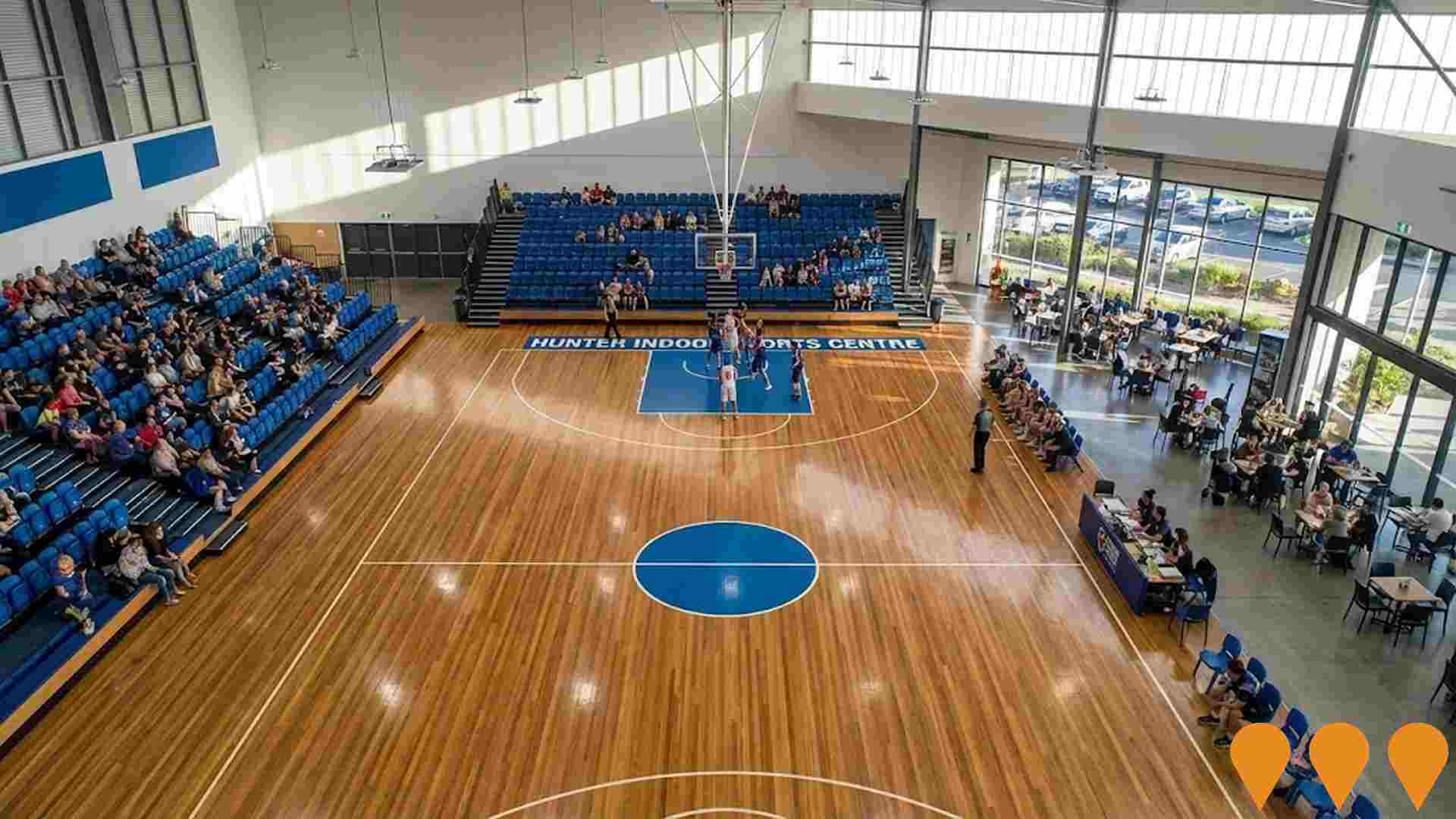
Callaghan Campus Heart
A multi-phase redevelopment project creating a vibrant central hub on the University of Newcastle's Callaghan campus. The project consolidates key student services within the Shortland Building and Auchmuty Library, creating seamless connections to services, support, retail, and events. Phase 1 includes works to the Auchmuty Library and Language Centre (December 2024-February 2025) and Shortland Building (May-October 2025). The project features new facilities for the University of Newcastle Students' Association (UNSA), a new commercial kitchen, student lounge, Central Service Point, ASKUoN hub, and refreshed reading room. Future phases are planned over the next three years to enhance student engagement, accessibility, inclusion, and campus life.
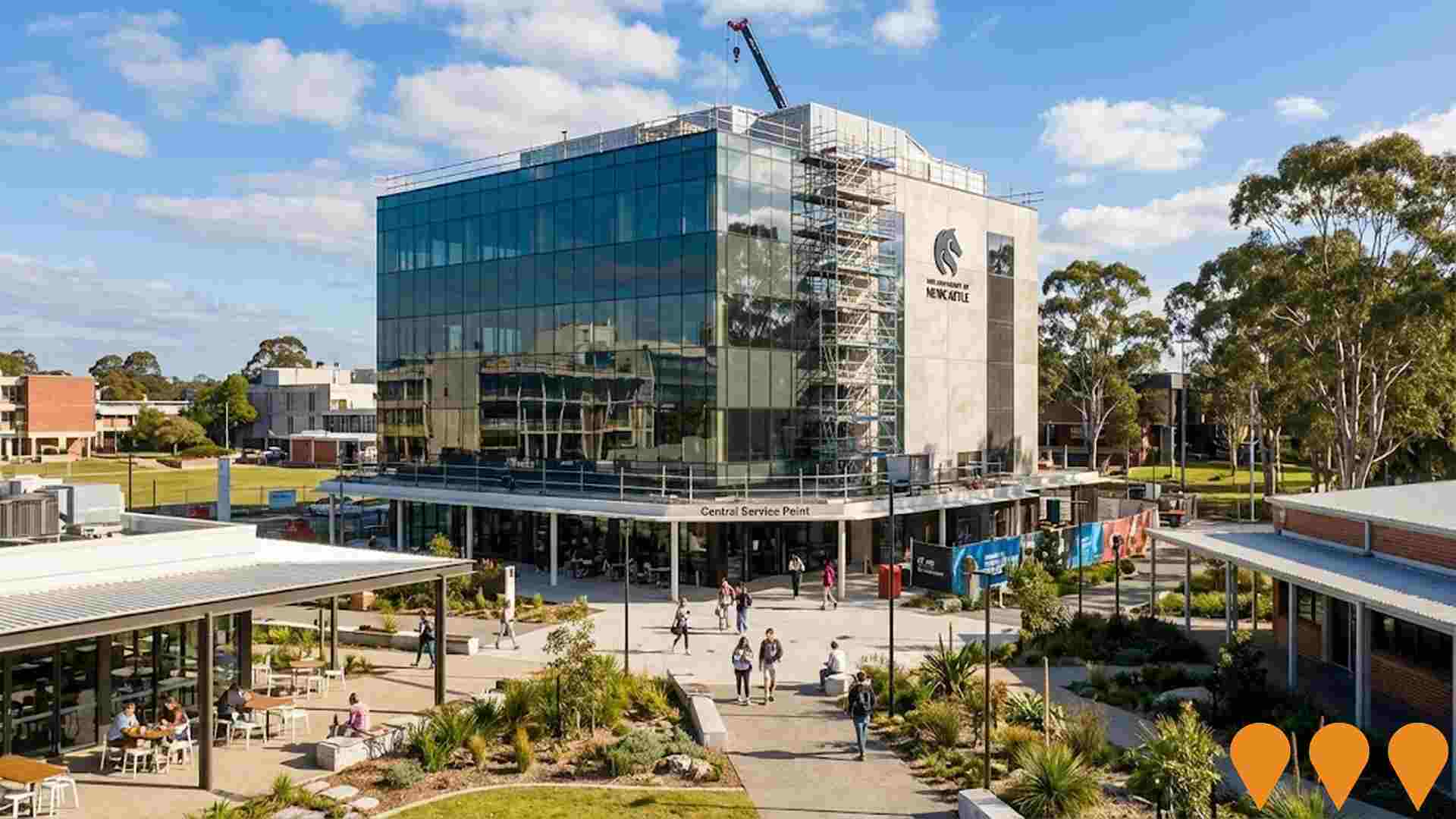
Transport Oriented Development Area - Hamilton Station
State-led planning reform allowing higher density residential development within 400 metres of Hamilton Station. The Transport Oriented Development planning controls commenced 13 May 2024, permitting residential flat buildings up to 22 metres (6 storeys) and shop top housing up to 24 metres with a maximum floor space ratio of 2.5:1. Development applications can now be lodged for residential flat buildings in residential and local centre zones, and shop top housing in commercial zones. All developments over 2,000 square metres gross floor area must include a mandatory 2% affordable housing contribution managed by registered community housing providers. Part of the broader NSW TOD Program aiming to deliver over 170,000 well-located homes near transport hubs across 37 stations over the next 15 years.

Newcastle Port Logistics Hub
A major distribution hub on 14.3 hectares at 51-71 Industrial Drive, Mayfield, providing purpose-built facilities for logistics, manufacturing, and agribusiness with excellent transport links. Construction has started on the $130 million first stage of the $225 million project.
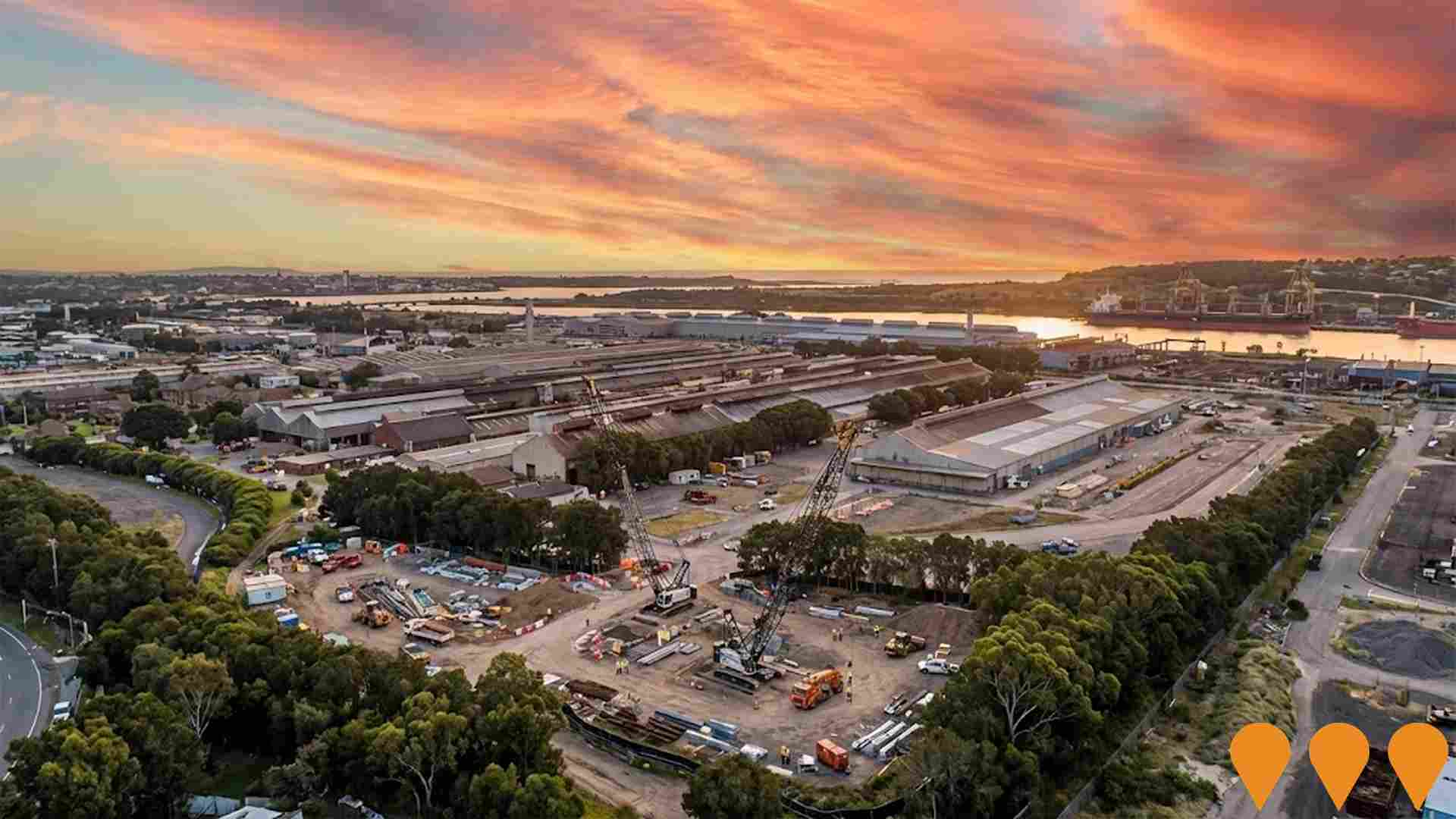
Mayfield Concept Plan
The Mayfield Concept Plan involves developing a 90-hectare port-side site for port-related activities, initially focusing on bulk liquids, with future opportunities for multi-purpose cargo facilities including a proposed $1.8 billion Multi-purpose Deepwater Terminal. Current operations include the Stolthaven Mayfield Terminal for bulk fuel storage, the Mayfield Cargo Storage Facility for various cargoes, and infrastructure upgrades such as the 2021-commissioned electrical substation. The plan aims to diversify the Hunter and NSW economies and improve supply chain efficiency. Adjacent state-owned Intertrade site is being developed by EnergyCo into a logistics precinct for renewable energy components storage and transport.

Hunter Park Precinct
$500 million mixed-use urban renewal project transforming 63 hectares around McDonald Jones Stadium into a sporting, entertainment, and lifestyle precinct. Includes 2,600 new homes, 50 hectares of public open space, state-of-the-art sporting facilities, entertainment venues, and 13,000sqm of commercial space.
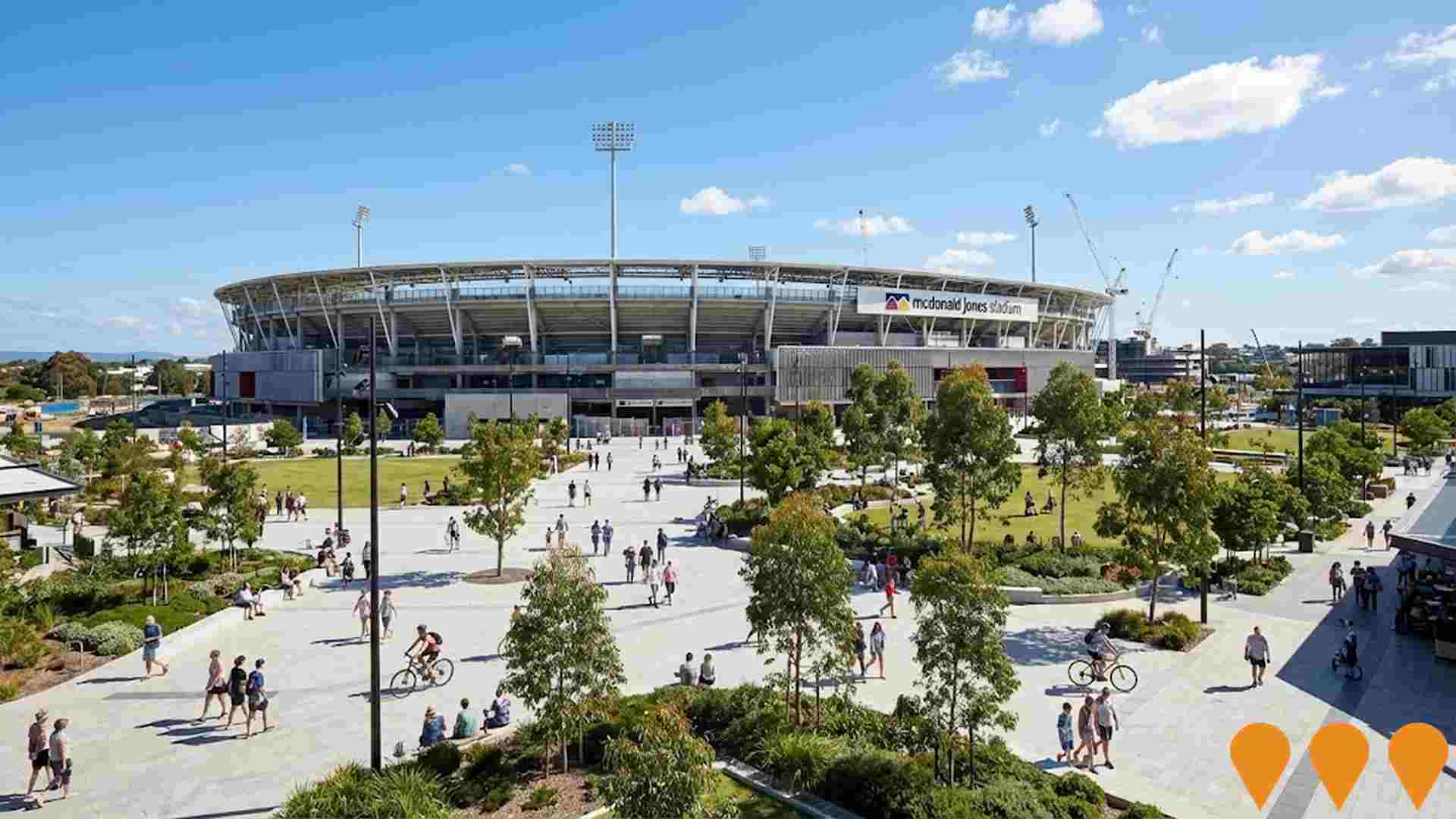
Newcastle Inner City Bypass - Rankin Park to Jesmond
The 3.4 km Rankin Park to Jesmond section is the fifth and final stage of the Newcastle Inner City Bypass. It delivers a new four lane divided road with three interchanges (southern at Lookout Road, hospital, and northern at Newcastle Road), removes up to 30,000 vehicles per day from local roads, and provides off road links for pedestrians and cyclists including a new steel arch bridge at the northern interchange. Traffic switches at Jesmond (Dec 2024) and Lookout Rd/McCaffrey Dr (mid 2025) mark major milestones. Opening to traffic is targeted for late 2025, weather permitting.
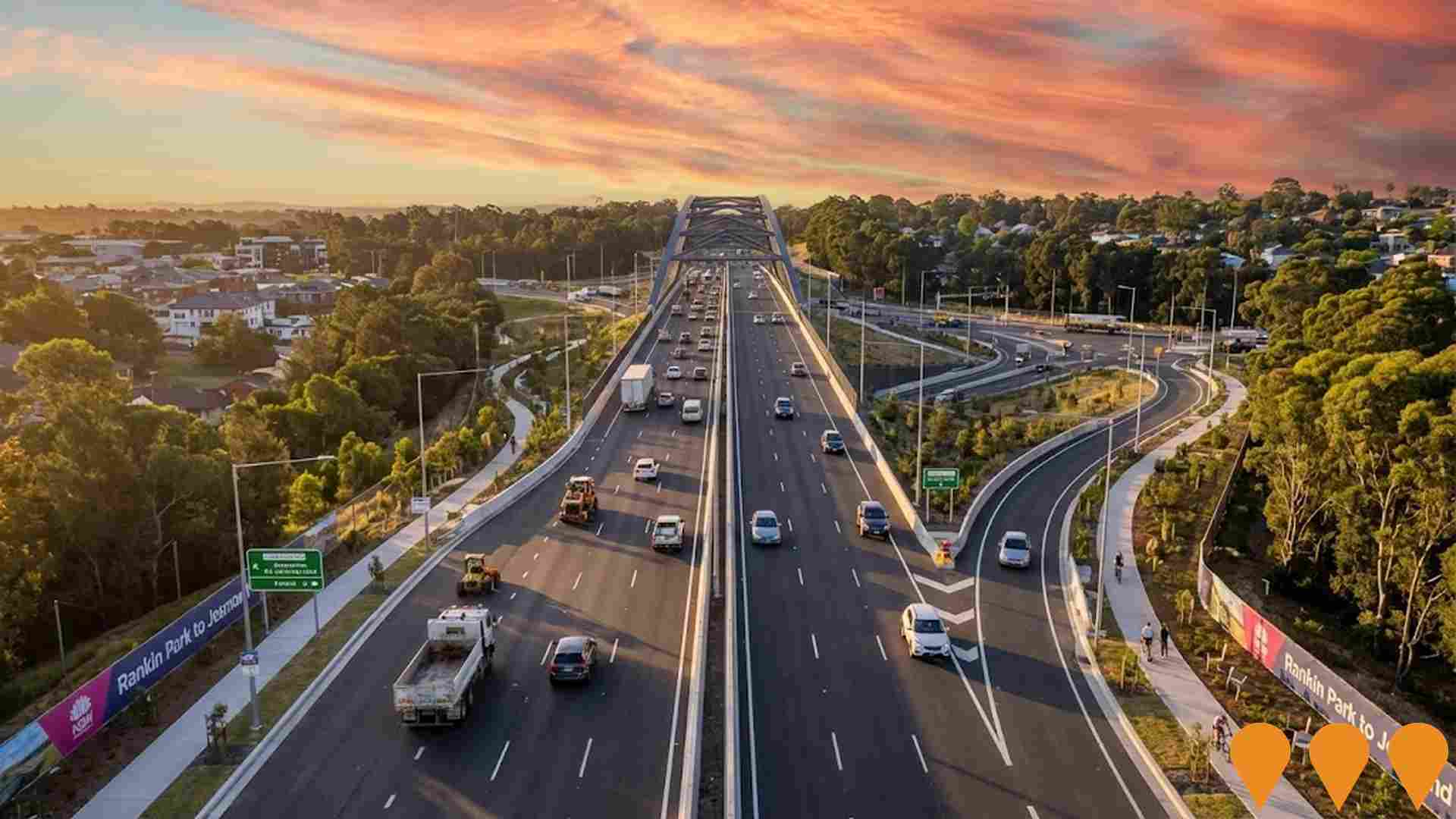
Employment
Employment performance in Mayfield - Warabrook has been below expectations when compared to most other areas nationally
Mayfield-Warabrook has an educated workforce with prominent representation in essential services sectors. The unemployment rate was 4.9% as of June 2025, with estimated employment growth of 1.8% over the preceding year.
As of that date, 8,834 residents were employed, with an unemployment rate of 1.3% above Rest of NSW's rate of 3.7%. Workforce participation was 62.7%, compared to Rest of NSW's 56.4%. Leading industries for employment among residents included health care & social assistance, education & training, and retail trade. Health care & social assistance had an employment share 1.3 times the regional level.
Conversely, agriculture, forestry & fishing was under-represented with only 0.5% of Mayfield-Warabrook's workforce compared to Rest of NSW's 5.3%. The worker-to-resident ratio was 0.7, indicating higher-than-average local employment opportunities. Between June 2024 and June 2025, employment levels increased by 1.8% while the labour force grew by 2.5%, resulting in a 0.7 percentage point rise in unemployment rate. In contrast, Rest of NSW saw employment decline by 0.1%, labour force growth of 0.3%, and a 0.4 percentage point increase in unemployment. National employment forecasts from Jobs and Skills Australia, released in May 2025, project national employment expansion of 6.6% over five years and 13.7% over ten years. Applying these projections to Mayfield-Warabrook's industry mix suggests local growth of approximately 7.0% over five years and 14.5% over ten years.
Frequently Asked Questions - Employment
Income
Income levels align closely with national averages, indicating typical economic conditions for Australian communities according to AreaSearch analysis
AreaSearch's data for financial year 2022 shows Mayfield - Warabrook's median income was $53,451 and average income was $62,683. This is below the national average. In comparison, Rest of NSW had a median income of $49,459 and an average income of $62,998. By September 2025, adjusted for Wage Price Index growth of 12.61%, estimated incomes would be approximately $60,191 (median) and $70,587 (average). The 2021 Census ranks Mayfield - Warabrook's household, family, and personal incomes modestly, between the 42nd and 51st percentiles. Income distribution shows that 33.4% of individuals earn between $1,500 and $2,999 annually, consistent with broader regional trends at 29.9%. Housing affordability pressures are severe, with only 81.2% of income remaining after housing costs, ranking at the 39th percentile. The area's SEIFA income ranking places it in the 4th decile.
Frequently Asked Questions - Income
Housing
Mayfield - Warabrook is characterized by a predominantly suburban housing profile, with a higher proportion of rental properties than the broader region
In Mayfield-Warrabrook, as per the latest Census evaluation, 75.7% of dwellings were houses, with the remaining 24.3% being semi-detached homes, apartments, or other types. This is in comparison to Non-Metro NSW's 70.5% houses and 29.5% other dwellings. The home ownership rate in Mayfield-Warrabrook was 25.4%, with mortgaged dwellings at 34.2% and rented ones at 40.4%. The median monthly mortgage repayment in the area was $1,883, below Non-Metro NSW's average of $1,962. The median weekly rent figure was recorded at $380, compared to Non-Metro NSW's $400. Nationally, Mayfield-Warrabrook's mortgage repayments were higher than the Australian average of $1,863, while rents exceeded the national figure of $375.
Frequently Asked Questions - Housing
Household Composition
Mayfield - Warabrook features high concentrations of group households and lone person households, with a lower-than-average median household size
Family households account for 59.8% of all households, including 22.0% couples with children, 24.3% couples without children, and 11.9% single parent families. Non-family households constitute the remaining 40.2%, with lone person households at 32.7% and group households comprising 7.4%. The median household size is 2.2 people, which is smaller than the Rest of NSW average of 2.4.
Frequently Asked Questions - Households
Local Schools & Education
Educational attainment in Mayfield - Warabrook aligns closely with national averages, showing typical qualification patterns and performance metrics
The area's educational profile is notable regionally, with university qualification rates at 29.3% among residents aged 15+, surpassing the Rest of NSW average of 21.3% and the SA4 region rate of 26.1%. Bachelor degrees are most prevalent at 20.2%, followed by postgraduate qualifications (6.6%) and graduate diplomas (2.5%). Vocational credentials are also prominent, with 34.4% of residents aged 15+ holding such qualifications – advanced diplomas comprise 10.0% while certificates account for 24.4%.
Educational participation is high, with 27.7% of residents currently enrolled in formal education, including 8.1% in tertiary education, 7.7% in primary education, and 5.2% pursuing secondary education. Six schools operate within Mayfield - Warabrook, educating approximately 1,777 students as of the latest data. The area demonstrates typical Australian school conditions (ICSEA: 1028) with balanced educational opportunities. The educational mix includes three primary, one secondary, and two K-12 schools. School places per 100 residents stand at 11.0, lower than the regional average of 15.6, indicating some students may attend schools in adjacent areas.
Frequently Asked Questions - Education
Schools Detail
Nearby Services & Amenities
Transport
Transport servicing is high compared to other areas nationally based on assessment of service frequency, route connectivity and accessibility
Public transport analysis reveals 153 active transport stops operating within Mayfield-Warabrook. These comprise a mix of train and bus services. They are serviced by 69 individual routes, collectively providing 5,584 weekly passenger trips.
Transport accessibility is rated as excellent, with residents typically located 126 meters from the nearest transport stop. Service frequency averages 797 trips per day across all routes, equating to approximately 36 weekly trips per individual stop.
Frequently Asked Questions - Transport
Transport Stops Detail
Health
Health performance in Mayfield - Warabrook is well below average with a range of health conditions having marked impacts on both younger and older age cohorts
Health data indicates significant health challenges in Mayfield - Warabrook affecting both younger and older age groups. Private health cover stands at approximately 51% of the total population (~8,235 people), slightly lower than the Rest of NSW average of 55.6%.
Mental health issues and asthma are the most prevalent conditions, impacting 13.7 and 8.8% of residents respectively. Around 60.8% of residents report no medical ailments, compared to 64.9% across Rest of NSW. The area has 15.4% of residents aged 65 and over (2,485 people), lower than the Rest of NSW average of 16.7%. Health outcomes among seniors present some challenges, broadly aligning with the general population's health profile.
Frequently Asked Questions - Health
Cultural Diversity
Mayfield - Warabrook ranks below the Australian average when compared to other local markets across a number of language and cultural background related metrics
Mayfield-Warabrook was found to have a below average level of cultural diversity, with 85.3% of its population born in Australia, 90.0% being citizens, and 90.2% speaking English only at home. The dominant religion in Mayfield-Warabrook is Christianity, which accounts for 45.2% of the population there. However, Judaism appears to be overrepresented, comprising 0.1% of the population compared to the region's average of 0.1%.
In terms of ancestry, the top three groups represented are English at 29.1%, Australian at 27.0%, and Irish at 9.5%. There are notable differences in the representation of certain ethnic groups: Welsh is notably overrepresented at 0.8% compared to the regional average of 0.8%, Macedonian at 0.6% (vs a regional average of 0.8%), and Samoan at 0.3% (vs a regional average of 0.1%).
Frequently Asked Questions - Diversity
Age
Mayfield - Warabrook's population is slightly younger than the national pattern
The median age in Mayfield-Warrabrook as of May was 36 years, significantly lower than Rest of NSW's average of 43 years and slightly younger than Australia's average of 38 years. The 25-34 age group constituted 21.8% of the population compared to Rest of NSW's percentage, while the 65-74 cohort made up 8.7%. This concentration of the 25-34 age group was higher than the national average of 14.5%. According to data from the 2021 Census, Mayfield-Warrabrook has seen a decrease in median age from 37 years to 36 years. The 25-34 age group grew from 19.3% to 21.8%, and the 35-44 cohort increased from 14.1% to 15.4%. Conversely, the 55-64 cohort declined from 11.4% to 10.0%, and the 45-54 group dropped from 11.3% to 10.1%. By 2041, projections indicate notable shifts in Mayfield-Warrabrook's age composition. The 25-34 age cohort is expected to grow by 925 people (26%), increasing from 3,505 to 4,431. Conversely, population declines are projected for the 65-74 and 15-24 cohorts.
